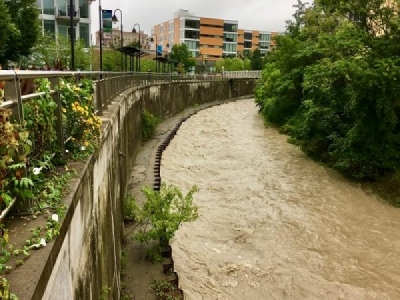
Posted on September 24, 2018
In 1935 Ithaca suffered its flood-of-record, with a series of thunderstorms leaving hundreds killed or displaced across the Southern Tier. In 1956, Ithaca saw a 100-year flood, costing millions in damage and turning Route 13 into a waterway. In 1972, Tropical Storm Agnes dumped seven inches of rain on the city, washing out roads, bridges and parts of Stewart Park.
The Southern Tier is seeing the remnants of Hurricane Florence this week, with about an inch of rain making creeks surge in Ithaca and more than two inches prompting a state of emergency in Tioga County.
When the next major rainfall comes, will Ithaca be ready to weather it?
Ithaca’s flood control channel, an almost 2.5-mile stretch of the Cayuga Inlet, needs to be dredged. The channel was built by the U.S. Army Corps of Engineers from 1965 to 1970 to provide an outlet for water when Six Mile Creek and Cascadilla Creek gush.
When the channel was built, it could hold the volume of water unleashed by the 1956 flood and significantly reduce damage from rains like those in 1935. Since then, the channel’s capacity has been reduced by sediment build-up.
According to a report by USACE, by 2011 sediment “reduced the capacity of the Cayuga Inlet to a point where it no longer is sufficient to contain the (FEMA Flood Insurance Study) 100-year event.” If the 1956 storm hit today, many streets would again be underwater, the report shows.
This map, produced by the U.S. Army Corps of Engineers, shows areas that would be inundated by a 100-year flood given current sediment levels in the Cayuga Inlet.
Dredging is the method used to remove sediment and restore channel capacity. The New York State Department of Environmental Conservation is responsible for periodically dredging the Cayuga Inlet to maintain its flood control capacity.
The last time the inlet saw a large scale dredging was in 1982, when the New York State Department of Transportation removed 202,000 cubic yards of sediment to make way for boats in the inlet, according to a 2015 report by the engineering firm O’Brien and Gere prepared for the Dormitory Authority of the State of New York.
The 2011 USACE study found that about 660,000 cubic yards of sediment would need to be removed to restore the flood channel to its original capacity. Sediment has continued to accumulate in the seven years since, so by the time dredging starts that volume will be larger.
So why hasn’t dredging started yet?
One hurdle has been the need for a dewatering facility, where sediment can be filtered from the water pumped out of the inlet. The City of Ithaca, in partnership with an environmental consulting firm and an engineering firm, produced a draft Environmental Impact Statement in 2011 that detailed plans to build a dewatering facility on land owned by the city behind Walmart and Lowe’s.
The state allocated $13 million to the project in 2012. That same year, a presentation by Lisa Nicholas, senior planner in the city’s Planning, Building, Zoning and Economic Development Department, called for the facility to be ready by fall 2013. Construction is not yet underway, however.
Dan Cogan, chief of staff for the City of Ithaca, said via email, “We are still waiting on NYS to complete construction documents for the dewatering facility that will be built behind Lowe’s. That facility needs to be constructed before the dredging can take place, and we have no control over the timeline, though we have been pushing as hard as we can to get that completed.”
Mike Thorne, superintendent of public works for the City of Ithaca, said via email that the dewatering facility is scheduled to be built in 2019.
Meanwhile, Thorne said the city is “trying to get a schedule and more information from the NYSDEC on the actual dredging work.”
Cogan said dredging “likely won’t begin until 2020 at the earliest.”
NYSDEC did not respond to requests for information about the project’s timeline.
While Ithaca waits for action from the state, flooding in nearby counties highlights the importance of preparing for major storms to come.
Source: The Ithaca Voice





